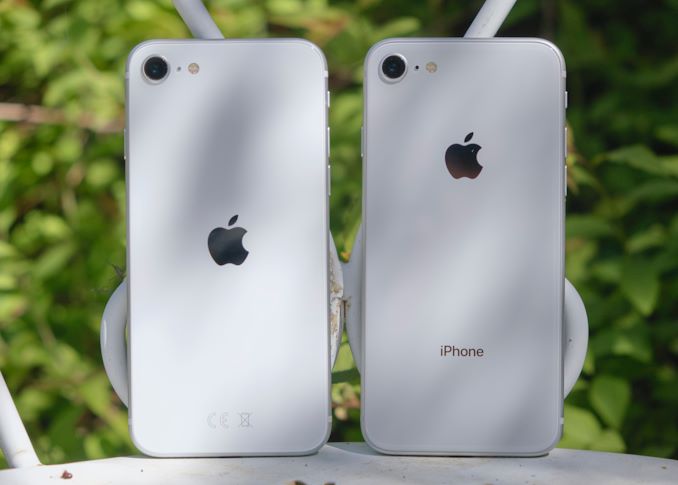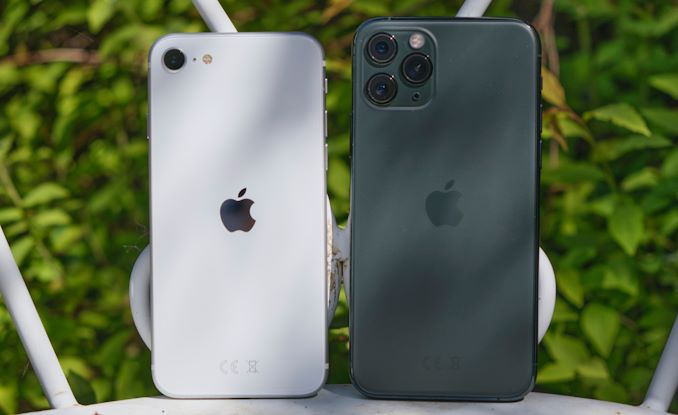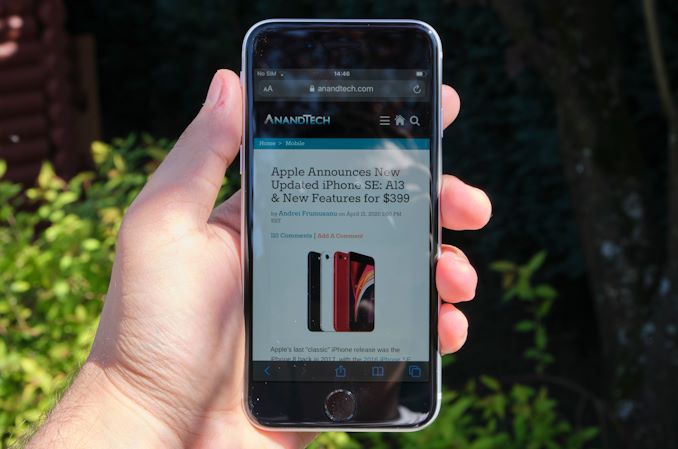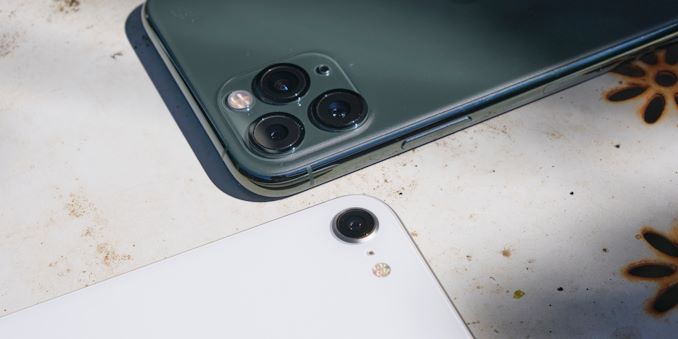The iPhone SE (2020) Review: A Reinvigorated Classic
by Andrei Frumusanu on April 24, 2020 6:30 AM EST- Posted in
- Mobile
- Apple
- Smartphones
- iPhone SE
- Apple A13
- iPhone SE 2020

Apple’s latest iPhone SE is being released today, and it’s certainly going to make a big impact on the market, for the simple reason that this is a $399 iPhone. We’ve had the new phone for a mere 24 hours, but we've been able to quickly put the device through its paces, showcasing the biggest differentiating factors for the phone – a device that can be essentially described as an iPhone 8 but with the brains of an iPhone 11.
In that sense, the second-generation iPhone SE is an extremely straightforward device. Externally, there’s very little that exposes it as a 2020 phone, with only the most minute design changes present. Powered by Apple's latest-generation A13 chip however, it’s hiding the strongest internal components in the market right now, easily beating any other device from the competition – at any price point. What’s left to be tested is how the new iPhone SE’s camera holds up, and if there’s any other noticeable differences between it, the iPhone 8, and the iPhone 11 series phones.
| Apple 2019-2020 iPhone Specifications | |||||
| iPhone 11 Pro | iPhone 11 Pro Max | iPhone 11 |
iPhone SE
|
||
| SoC | Apple A13 Bionic 2 × Lightning Performance @ 2.66GHz 8MB L2 4 × Thunder Efficiency @ 1.73GHz 4MB L2 |
||||
| GPU | Apple, 4 Cores | ||||
| DRAM | 4GB LPDDR4X | 3GB LPDDR4X | |||
| Display | 5.8-inch OLED 2436×1125 DCI-P3/True Tone 800 cd/m² brightness 2M:1 contrast ratio |
6.5-inch OLED 2688×1242 DCI-P3/True Tone 800 cd/m² brightness 2M:1 contrast ratio |
6.1-inch LCD 1792×828 DCI-P3/True Tone 625 cd/m² brightness 1400:1 contrast ratio - |
4.7-inch LCD 1334×750 DCI-P3/True Tone 625 cd/m² brightness 1400:1 contrast ratio - |
|
| Size | Height | 144.0 mm | 158.0 mm | 150.9 mm | 138.4 mm |
| Width | 71.4 m | 77.8 mm | 75.7 mm | 67.3 mm | |
| Depth | 8.1 mm | 8.1 mm | 8.3 mm | 7.3 mm | |
| Weight | 188 grams | 226 grams | 194 grams | 148 grams | |
| Battery Life | 3046mAh +14.5% capacity "+4H vs XS" |
3969mAh +25% capacity "+5H vs XS Max" |
3110mAh +5.7% capacity "+1H vs XR" |
1810mAh +0% capacity vs iPhone 8 |
|
| Wireless Charging | Qi | ||||
| Rear Cameras | Main | 12 MP 1.4µm Dual Pixel PD f/1.8, OIS Wide Color Gamut Quad LED True Tone Flash |
12 MP 1.4µm f/1.8, OIS Wide Color Gamut Quad LED True Tone Flash |
||
| Tele- Photo |
12 MP f/2.0 Telephoto, OIS 2x Optical Zoom |
- | - | ||
| Wide | 12MP f/2.4 120° Ultra-wide Angle |
- | |||
| Front Camera | 12MP f/2.2 Wide Angle | 7MP f/2.2 | |||
| Storage | 64 GB 256 GB 512 GB |
64 GB 256 GB 512 GB |
64 GB 128 GB 256 GB |
64 GB 128 GB 256 GB |
|
| I/O | Apple Lightning | ||||
| Wireless (local) | 802.11ax Wi-Fi with MIMO + Bluetooth 5.0 + NFC | ||||
| Cellular | Gigabit-class LTE-A 4x4 MIMO and LAA |
Gigabit-class LTE-A 2x2 MIMO and LAA |
Gigabit-class LTE-A |
||
| Splash, Water, Dust Resistance | IP68 up to 2 meters (Pro models = 4 meters), up to 30 minutes |
IP67 up to 1 meters, up to 30 minutes |
|||
| Dual-SIM | nano-SIM + eSIM | ||||
| Launch Price | 64 GB: $999 / £1049 / 1149€ 256 GB: $1149 / £1199 / 1319€ 512 GB: $1349 / £1399 / 1549€ |
64 GB: $1099 / £1149 / 1249€ 256 GB: $1249 / £1299 / 1419€ 512 GB: $1449 / £1499 / 1649€ |
64 GB: $699 / £729 / 799€ 128 GB: $749 / £779 / 849€ 256 GB: $849 / £879 / 969€ |
64 GB: $399 / £419 / €479 128 GB: $449 / £469 / €529 256 GB: $549 / £569 / €649 |
|
Hardware-wise, the iPhone SE is anything but a budget or middle-range phone. Being powered by Apple’s A13 SoC, the company didn't spare any expense by going for a previous generation chipset, and rather used the latest and greatest they had available. What this means is that performance-wise, the new iPhone SE essentially should be on par with the iPhone 11 series – which in turn means that alongside its siblings, the new SE will be the most powerful mobile phone on the market right now.
As to why Apple chose to do this, I think it’s just a simple matter of projected longevity of the phone. Apple might not be producing previous generation A-series chipsets for much longer whereas the iPhone SE is a new product that will need to be supported (and likely to be produced) for several years into the future. Choosing the A13 here might not be the cheapest option at the very beginning of the phone’s lifetime, but it’s certainly going to pay off long-term when it comes to production as well as support.
Apple gives the iPhone SE 3GB of LPDDR4X RAM – one less GB than the iPhone 11 series, but still significantly more than past iterations of iPhones. Other internal component upgrades are the new cellular modem which is on par with the iPhone 11 series, and the new WiFi 6 combo chip that now also provides Bluetooth 5.0 connectivity.
While I generally prefer black front bezels on smartphones, it’s a so-so choice for the iPhone SE. On one hand it focuses you more on the screen content, however the black is also a lot more a finger-print magnet, and I did think the white iPhone 8 looked quite nice as it was. Holding both phones side-by-side, the back front does feel “older” and less modern than the white variant. I guess it’s a matter of preference.
As for the display, the only difference between the 4.7-inch iPhone SE and the iPhone 8’s own 4.7-inch, 1334 x 750 resolution IPS LCD is the fact that the new screen lacks 3D Touch. Instead, Apple is favoring the new long-press haptics that were introduced in the iPhone 11 series.
From the back, there’s also some very slight design changes. First of all, the new logo is centered, and the “iPhone” marking is gone, compared to the iPhone 8’s back glass design.
Interestingly, the new white design is actually significantly whiter than the iPhone 8’s white on the back glass, it now matches the brighter tone that was previously found on the front bezels. It does allow the white to pop out a lot more and I do prefer this shade.
The only other minuscule difference between the two phones is the fact that the back microphone and bottom speaker’s black mesh has been replaced with a silver one, more closely matching the white theme of the phone.
Size-wise, compared to contemporary phones, the iPhone SE has an outright diminutive stature. Compared to the iPhone X/XS/11 Pro body, which for the last two years has been Apple’s smallest form-factor device, the iPhone SE feels tiny, not only in its dimensions, but also in terms of weight.
The weight difference however does come with one big caveat: the iPhone SE shares the same battery as the iPhone 8, meaning it comes in at a tiny 1810mAh. That’s a huge disadvantage compared to the bigger capacities of the new iPhone 11 series phones, but the iPhone SE is also sporting a very small and very efficient display panel. Apple claims battery life is in line with the iPhone 8 – a claim we’ll verify later in the mini-review.
Overall, it’s been refreshing to use a smaller form-factor phone these days. I have no doubts that a very large part of the potential buyers of the iPhone SE will be those that just aren’t willing to switch to the bigger and heftier devices that have become the norm in the last few years. It’s a dying breed of phones, and the iPhone SE here no doubt is catering both for nostalgia and smaller-form-factor market.
Camera-wise, that’s where we’ll be seeing some quite larger differences between the new iPhone SE and its contemporary siblings. Whilst the A13 and its new ISP will be no doubt upgrading the image processing abilities of the phone, its hardware is still only similar to that of the iPhone 8. Apple here uses the same generation sensor, which means it’s significantly smaller than what’s found on the iPhone 11’s – and of course there’s only one module. We did some quick camera testing and found some differences to the iPhone 8’s capturing ability – some positive but also some negatives, read more in the later section.
Overall, the iPhone SE is taking the physical formula that should be well tested and proven by almost 500 million users out there. It’s certainly not a modern-looking phone, but it remains unique in the market today due to its size and light weight.















196 Comments
View All Comments
name99 - Saturday, April 25, 2020 - link
"In JetStream, the phone even gets a boost here, which might be due to the newer iOS version."Not "might be", *is* a result of newer iOS. Apple's constantly improving Safari performance.
Some of the tech behind the most recent improvements is detailed here:
https://webkit.org/blog/10298/inline-caching-delet...
LeftSide - Saturday, April 25, 2020 - link
Could the oddly close battery life numbers be related to the oddly close name of a particular apple employee and the name of this site?yeeeeman - Sunday, April 26, 2020 - link
With this article my suspicion of you guys being either paid my Apple or Apple fanboys has been confirmed.There are a ton of interesting, cheap Android devices in THE SAME price category as this old junk, but you never get the time to cover them. Some of them even have SD865 and the lot at close to same price as this phone, but neah, don't bother to write about them.
No, you instead waste your time and our time to write a long article, to repeat basically all that was valid for iPhone 6 in 2015. Sure, you are free to do it, you are the writer.
Sorry to be so harsh, but I feel like this site is going into a wrong direction.
toyeboy89 - Monday, April 27, 2020 - link
The fact is that Apple is more popular. They are going to get more hits on an article for a new iPhone. Just because a design is old doesn't make it junk. It's a proven design that many people still prefer to the swiping gesture based controls of the newer full screen iPhones. Most people don't look into these off brand budget phones you speak of for the same price. I personally wouldn't risk spending $400 on a brand with no service center in my country, Apple is everywhere, and you can walk into a store and get service the same day on your device.trparky - Friday, May 1, 2020 - link
A lot of those cheap Android phones are from China. That's a hard NOPE in my mind.shady28 - Sunday, April 26, 2020 - link
Honestly my untrained eyes can't see much if any difference between the iPhone 8 and SE 2020 video. I do see a slight but noticeable difference vs the iPhone 11 Pro video though.There is at least one side by side speed comparison with the SE and 8 out there now. Basically, normal stuff it's a toss up. But in more demanding applications, longer loading apps and so on, there's a pretty large difference.
My take on all this is that the SE 2020 is essentially a more future proof variant of the 8, but the 8 is still a very capable and fast phone to the point where the differences are undetectable except under the most demanding of apps (there is a significant difference in the comparison when the phones are pushed, but how many people push their phones SoC to the limit with any frequency?). This shouldn't be too surprising, any competing phone running less than a Snapdragon 845 is going to get thumped hard on performance by the iPhone 8 - which is to say anything short of a 2019+ flagship android.
So, as an 8+ owner who disdains facial recognition, I'm not seeing this as much of an upgrade path. I don't want to go back to the smaller screen, my camera is already better than an normal 8 and probably better than this 2020 SE, and I'm not interested in losing my home button on the new iPhones.
Deicidium369 - Sunday, April 26, 2020 - link
Yeah I remember when my Atari 800XL with disk drive was future proof.toyeboy89 - Monday, April 27, 2020 - link
To be fair CPU and GPU in phones have plateaued in recent years so shady28 does have a good point.Drakkon801z - Monday, April 27, 2020 - link
I don't understand about bezels, phones with thicker bezels have higher chace to survive after accidental drops, I lost cout of how many thin bezel phones that has latest version of protective screen, been smashed/cracked just because of 30 cms drop. For practical purposes, thicker bezels is like the only choice, unless you add good quality material like higher quality quartz/sapphire glass to entire front. Untill then, I will prefer thicker bezels on my phones.pav1 - Monday, April 27, 2020 - link
As usual, Anandtech reviews dote on CPU, giving us an A13 review which we already know is fast and largely wasted on such a device.